A Conversation With Dana Stabenow
by Claire E. White
Edgar Award-winning mystery author Dana Stabenow was born in Anchorage, Alaska on March 27, 1952, and was raised on a 75-foot fish tender in the Gulf of Alaska. Her mother was a deckhand on a salmon tender called the Celtic, for five years,
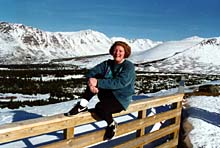
|
After graduating from Seldovia High School in 1969, she put herself through college working as an egg grader, bookkeeper and expediter for Whitney-Fidalgo Seafoods in Anchorage. She received a B.A. in journalism from the University of Alaska in 1973. After graduation, she spent one more summer knee-deep in humpies and then spent everything she earned on a four-month backpacking trip to Europe with her college roommate where she says she "discovered English pubs, German beer and Irish men."
After returning home, construction began again on the TransAlaska Pipeline, and so she set off to work for Alyeska Pipeline at Galbraith Lake and later for British Petroleum at Prudhoe Bay, spending her holidays in Hawaii. In 1982, she turned 30, and began to ask herself how she wanted to spend the rest of her life. She left the Slope in 1982 and enrolled in UAA's MFA program, from which she graduated in 1985. Her goal was to sell a book before she went broke. She says she just barely made it: Second Star was bought by Ace Science Fiction in 1990.
In 1991 Laura Anne Gilman, her editor at Ace, found out about the existence of a mystery novel Dana had written, A Cold Day for Murder. After reading it, she offered Dana a three-book contract featuring Kate Shugak as the main character.
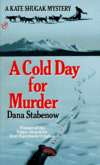
|
Dana attributes her work ethic and her success mostly to her mother, about whom she says, "I grew up believing I could do anything because my mother showed me how. She could bake bread, shoot and skin and butcher a moose, shoot, pluck and cook ducks, help maintain and run a boat, count fish, fool the Fish and Game, skin a mink and tan its hide, homeschool me the year we trapped...Because she could do anything, I could, too. It was her gift to me."
Dana spoke with us about how she got her start as an author, how she created her two popular mystery series, and shares her insights on what writers need to know about the business side of writing.
What was it like growing up on a 75-foot fish tender in the Gulf of Alaska?
When you're a kid, your life is just your life. We lived on a boat. I slept in a bunk instead of a bed, I ate at a galley table instead of a kitchen nook, I played in a focsle instead of a front yard, I climbed a 42-foot ladder to get to school instead of taking a bus. What, you didn't?
What's your most vivid memory of the experience?
Climbing that damn ladder. The baby gray whale who mistook us for its mother. How few and far between the sea otters were then. The meteor shower on the way back from Kamishak Bay. The smell of salmon. Losing the bucket over the side five times in a week while trying to pull in water to flush the head toilet.
How did you keep focused and positive during the 5 years between receiving your MFA and the time your first SF book was published?
It was six years, actually. When I left my job with BP on the North Slope, my goal was to sell a book before I ran out of savings. I would never admit, at least out loud, to the possibility of any other outcome. Never give up, never surrender, no matter how many of my manuscripts came back from New York like little homing pigeons.
What led up to your first mystery book, A Cold Day for Murder, being published?
My sf editor at Ace, Laura Anne Gilman, said, "What else have you got?" after Second Star came out. A Cold Day For Murder was my answer, a mystery I'd written three years before and never tried to sell.
Let's talk about your most recent mystery series which stars Alaskan State Trooper Liam Campbell. How did the Liam Campbell series come into being?
It's all Laura Anne's fault. She moved from Berkley to ROC/Dutton and wanted me to write a series based on Chopper Jim, the trooper character in the Kate Shugak series. I couldn't write one about Jim as he was part of the Kate ensemble on contract to Putnam, so I came up with Liam instead.
Although both the Kate Shugak series and the Liam Campbell series are set in the Alaskan wilderness, the series are very different in tone and focus. How did you create the character of Liam?
He comes from a true incident in Denali Park where three people died of exposure. I always wondered what happened to the trooper responsible. This was my answer.
In So Sure of Death, the second Liam Cambell book, you have Liam perform a pretty incredible stunt. How did you decide to write that scene?
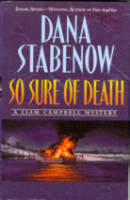
|
The Liam Campbell series is sexier than the Kate Shugak series. Does that make it more fun to write?
Do I breathe heavily over those scenes? You bet. Wy would have a fight on her hands if Liam was real.
The wonderful Alaskan scenery is a character itself in both series. You seem to see your surroundings with as much wonder as someone from out of state would -- you don't take such grandeur for granted, as some people might. What do you love most about living in Alaska?
Alpenglow on the Chugach Mountains. The moose nibbling on the mountain ash in my front yard. The drive to Homer. The flight to Seldovia. The first taste every year of Copper River kings. The hog-on-ice independence of Alaskans. We don't take no shit from nobody.
Which series do you find more challenging to write?
Both, because my writing seems to be evolving from a single viewpoint to multiple viewpoints and from a single plot to multiple plots. Makes everything I write that much more complicated.
I'd like to talk about your other series, the Kate Shugak series. How did you create the character of Kate? Why did you choose to make her a Native Alaskan, an Aleut?
I was visiting my aunt, who then was living in Long Lake, about twenty-five
| "Beginning writers are abysmally ignorant about the business of writing. I was, and it led to my essentially giving away my first eight books. If I can help one wannabe understand the difference between joint and separate accounting in a multi-book contract, I'm happy." |
How has Kate's character evolved over time from the first book in the series to present?
She was very, very angry in the beginning, and very isolated by that anger. She was mad at everybody, mad at the child abusers in Anchorage that she went after for five years, mad at Jack, mad at her grandmother, mad at the world. She works through her anger with Jack by the end of A Cold Day For Murder, she begins to reconcile with Emaa by the end of A Cold-Blooded Business, and she has begun to accept her place in her community by Breakup. I think she'll always be a loner in the sense that the central figures of detective novels always are, but she is slowly becoming more a member of, and although she'd scream to hear me say it, more responsible to her family, her tribe and her community.
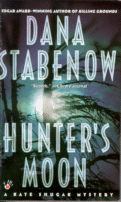
|
The setting for Hunter's Moon is a real place, it's a defunct gold camp south of Denali. My father found it when he was out flying one day and bought it. His wife Jeannie and I spent four days there a couple of years ago and I thought then, "What a great place to retell The Most Dangerous Game."
What's the most difficult aspect of writing a series character? How do you balance the need for some explanation of the character for the new readers with the needs of continuing readers?
As my editor once said, "Welcome to the world of genre fiction, Dana." It's tough, it's a great temptation to just cut and paste the same backstory from one book to the next. But if you work at it, retelling the same facts about your characters can tell you new things about them. For example, in Midnight Come Again (the tenth Kate Shugak mystery coming out from St. Martin's in May 2000), I have Jim Chopin, the state trooper in the series, tell what he knows of Kate's history. The fact that he has made it his business to learn that much about her tells us something about him, and we learn a few new things about her as well. That was fun to write.
In both of your series books, the law enforcement officers are portrayed in a positive light. They have flaws, but at their core they are honest, hardworking and have a passion for justice. What went into your decision about how to portray these characters this way? When did you first meet an Alaska State Trooper? How did that experience affect you?
The first trooper I ever saw was when I was a kid in Seldovia. We didn't have our own trooper (even now there are less than 300 in the whole state) so when somebody got killed in a bar fight the trooper from Ninilchik had to fly in. He was the biggest man I'd ever seen, and he walked very slowly and he talked even more slowly than that and he didn't get excited. He was the living, breathing embodiment of the law of the land. Trouble came to my town and then the trooper came, and the trouble went away. I've never forgotten him, and I suppose all the troopers I write are in some part based on him. Absolutely authority, absolute integrity. I can hardly bear to write about bad troopers, like Corcoran in Fire and Ice.
Tell us about the next Kate Shugak book, Midnight Come Again.
It's the tenth in the series, the first to come out from St. Martin's. It takes place ten months after the traumatic events of Hunter's Moon, and Kate Shugak is missing from the Park. Her homestead is deserted and even Bobby doesn't know where she is. I think that's all I'm going to say about it.
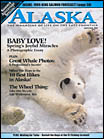 How do you find the time to juggle writing two mystery series and the
travel column for Alaska Magazine?
How do you find the time to juggle writing two mystery series and the
travel column for Alaska Magazine?
I'm very anal about work. My mother and father both were the Protestant work ethic personified, if you could crawl, you went to work, even if you had to crawl over broken glass to get there. Writing is a job like any other in that to get paid, you must produce. So I make sure I produce.
I'd like to talk about the actual mechanics of writing. Take us through a typical day in the writing life of Dana Stabenow.
I get up at 5:30 a.m. every morning, I'm at work at my computer by 7 a.m., I answer my email and take care of the business of writing (always a pain in the ass, but a necessary one) until 8 or 9 a.m. and then I go to real work. I write ten pages a day, every day, no exceptions except for days when I have to look at copyedits or do line edits of pass proofs or print out a manuscript. I try to have a manuscript done early enough before deadline so that I can let it sit for a week or two before doing the edit. Then it goes into New York where my editor, the copy editor and the typesetter rightfully tear it to shreds.
In your seminar on the business of writing, what do you tell aspiring writers about how to write a really great query letter?
Keep it to one page. First paragraph, introduce yourself. Second paragraph, introduce your work. Third paragraph, add anything important you left out before, like potential markets. Fourth paragraph, say goodbye and get out. And did I mention? Keep it to one page. Editors are busy people.
What's your advice to the aspiring mystery writer who is feeling a bit rejected in his or her career, so far?
Keep writing. Write every day, even if it's only one paragraph a day. That's one paragraph more than you had the day before, and by the end of the month you might have a chapter. If you don't use your skills, you'll lose them, and then you'll truly never get published. And keep your stuff in the mail, not on your desk. It won't sell from your desk.
What do you like most about teaching?
The ability to give newbies a leg up. Beginning writers are abysmally ignorant about the business of writing. I was, and it led to my essentially giving away my first eight books. If I can help one wannabe understand the difference between joint and separate accounting in a multi-book contract, I'm happy.
How much do you use the Internet?
I have my own website, www.stabenow.com.
| "Write every day, even if it's only one paragraph a day. That's one paragraph more than you had the day before, and by the end of the month you might have a chapter. If you don't use your skills, you'll lose them, and then you'll truly never get published." |
Let's talk about another genre you like and support -- romance. Have you really encountered "The Sneer" after telling someone you enjoy reading romance novels?
It's akin to "The Grimace" I get when I tell people I read science fiction. I don't understand people who won't take a chance on another genre. Diana Gabaldon writes great books, period, never mind that they are historical romance. Same as Steven Gould, who writes some of the best sf going today. I defy anyone to read Jumper and not fall in love with this guy's work.
When you're not working, what are your favorite ways to relax and have fun?
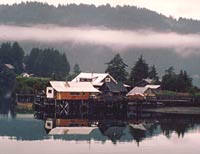 Houses on Seldovia Slough |
Photo of Dana Stabenow by Linda Longstaff.
Return to the February 2000 issue of The IWJ.
More from Writers Write
